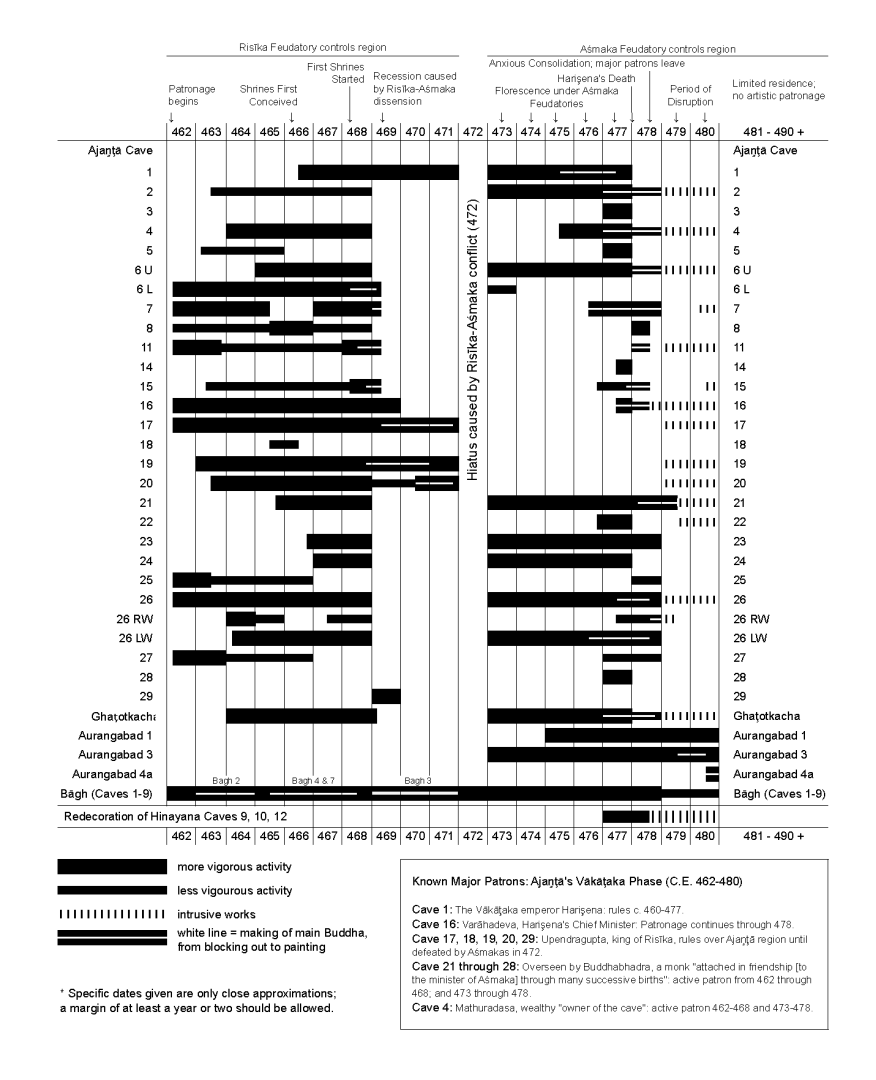Introduction
Ajanta Cave 1, located at the far end of the Ajanta site’s horseshoe-shaped scarp, is a crucial part of the site’s architectural development. This location illustrates the expansion from the central area towards the ends of the scarp. The cave represents a significant period in the history of art and architecture, showcasing the skills and creativity of its builders.1
Period
The construction of Cave 1, according to the chronology suggested by Walter M. Spink, started around 466 CE. The building process faced several disruptions. An economic downturn around 469-471 CE and a pause in 472 CE temporarily halted the work. The works resumed around 473 CE but were unexpectedly discontinued by the end of 477 CE. This sudden stop left the cave temple slightly unfinished, providing a unique insight into the historical context of that era.2

Architectural Plan
The architectural layout of Cave 1 is a reflection of its era, characterized by a blend of sophisticated design elements. The structure includes a frontcourt leading to a detailed facade. Originally, a double-pillared portico, now no longer present, formed the entrance to a grand pillared porch. This porch leads into a large hall, structured around twenty pillars organized in a square pattern. The hall is surrounded by fourteen monastic cells, contributing to its utility and complexity. The presence of two additional cells on the porch and four in the pavilions at the frontcourt further enhances the temple’s structure. These pavilions, set on an elevated plinth, function as the temple’s lateral extensions, each with its own facade. The entire facade is unified by a continuous entablature, linking these elements in a cohesive architectural design.
Paintings
The walls, pillars, and ceilings of Ajanta Cave 1 are adorned with an array of exquisite paintings, each serving as a window into the rich artistic heritage of the period. Notably, every surface, except the floor, was intended to be covered with art, though some areas remain incomplete, providing insight into the artistic processes of the time.
- Narrative Paintings: These paintings depict ancient Buddhist legends about the life of Śākyamuni as well as about his former births as a Bodhisatva. There are 15 distinct narrative themes, including the tales of Maitribala, Mahāsudarśana, Śibi-Kapota, Udrāyaṇa, Sudhana, Śaṅkhapāla, Janaka, Kalyāṇakārin, an unidentified scene, Mahoṣadha, Māravijaya, Mahāprātihārya, Campaka, Nāgakumāra, and Prabhāsa. Each painting is not just an artistic expression but also a storytelling medium, capturing the essence of Buddhist teachings.3
- Devotional Paintings: The depictions of the Bodhisatva Kings stand out among the devotional themes. Set against landscapes with rugged mountains, these paintings are strategically placed along the temple’s axis. In the porch: flanking the main entrance door; in the hall: flanking the entrance to shrine antechamber. In the shrine antechamber: flanking the entrance door to the inner shrine. Thus, from the porch to the inner sanctuary, the Bodhisatva king in a mountainous landscape serves as door keepers. The Bodhisatvas were favourite devotional themes.
- Decorative Paintings: The decorative aspect is most prominent in the ceiling and pillar paintings, reflecting the grandeur of contemporary palatial interiors. The detailed motifs at the intersections of beams and rafters feature a diverse array of human figures, animals, birds, and mythical creatures, each adding to the overall decorative scheme.4
Sculptures
Cave 1 is equally renowned for its sculptural elements, which adorn both its exterior and interior. These sculptures, varying from narrative to decorative themes, display a high level of craftsmanship and attention to detail.
- Narrative Sculptures: On the exterior, the friezes narrate key events such as Siddhartha’s encounter with the four omens and his decision to renounce his princely life. Inside the sanctum sanctorum, a nearly three-dimensional sculpture depicts Śākyamuni delivering his first sermon in the dharmacakra-pravartana mudrā. The sculpture, flanked by the symbolic dharmacakra and deer, is a visual representation of a pivotal moment in Buddhist history.
- Decorative and Ornamental Sculptures: Beyond their narrative significance, the sculptures also serve a decorative purpose. The intricate designs on pillars, pilasters, capitals, lintels, façades, and doorframes showcase a variety of ornamental motifs. Each element not only embellishes the cave but also reflects the artistic and religious milieu of the time.
- For an early account, vide Fergusson, James and James Burgess. 1880. The Cave Temples of India (London: W. H. Allen), pp. 320-332. ↩︎
- For a systematic chronological study, vide Spink, Walter M. 2007. Ajanta: History and Development, Vol. 5. Cave by Cave (Leiden and Boston: Brill), pp. 17-40. For a rather different account of the chronological development, vide Singh, Rajesh Kumar. 2012. An Introduction to the Ajanta Caves: With Examples of Six Caves (Baroda: Hari Sena Press), pp. 50-75. For a larger periodisation framework, vide Singh, Rajesh Kumar. 2020. Periodisation of Rock-Cut Monuments of India (Baroda: Hari Sena Press). ↩︎
- Schlingloff, Dieter. 1999. A Guide to the Ajanta Paintings. Vol. 1. Narrative Wall Paintings (Delhi: Munshiram Manoharlal), pp. 1-12. Schlingloff, Dieter. 2013. Ajanta–Handbook of the Paintings. Vol. 1. Narrative Wall Paintings (New Delhi: IGNCA). Singh, Rajesh Kumar. 2019. Ajanta Paintings: A Compilation of 84 Abridged Narratives (Baroda: Hari Sena Press), pp. 19-37. Singh, Rajesh Kumar. 2017. Ajanta Cave No. 1: Documented According to the Ajanta Corpus of Dieter Schlingloff (Baroda: Hari Sena Press). ↩︎
- Zin, Monika. 2003a. A Guide to the Ajanta Paintings. Vol. 2. Devotional and Ornamental Paintings (Delhi: Munshiram Manoharlal), pp. 1-5. Zin, Monika. 2003b. Ajanta — Handbuch der Malereine / Handbook of the Paintings 2, Devotionale und Ornamentale Malereien / Ornamental and Devotional Paintings (Wiesbaden: Otto Harrassowitz). ↩︎
